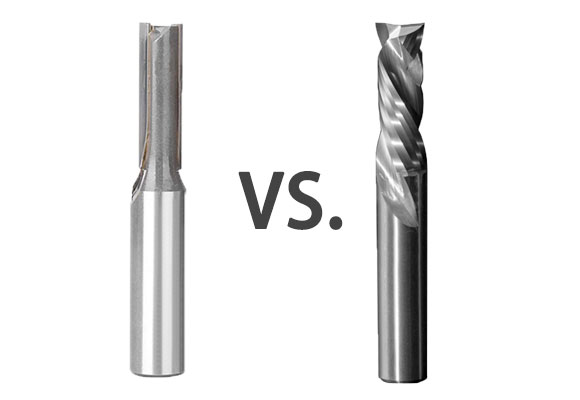
Spiral vs. Straight Router Bits: Which One Is Better For Your Project?
Standard straight router bits are the most commonly used type of router bits for woodworkers. They can perfectly finish the job with less cost. However, spiral router bits are increasingly popular for leaving a cleaner cut. So do we really need to upgrade to spiral router bits? As for spiral vs. straight router bits, there’s no absolute winner. Remember to choose the right bit that best fits your project.
Both spiral and straight router bits can plunge into the workpiece
The tips of spiral bits are similar to drill bits, with the tip end of the flute ground. So, we can plunge a spiral router bit directly into a wood board from the surface. However, because of the design of the straight router bit tip, there’s no cutting happening during the plunging process. If we try to plunge with a straight bit, the workpiece will be scraped. While working with a straight router bit, it is still possible to make plunges or create mortises, but we need to sweep the router during the process. It is highly recommended to plunge less than one inch.
Straight router bits have various sizes and bearing configurations
The cutting diameters of solid carbide spiral router bits are usually the same or smaller than their shanks, so it’s hard to find a spiral bit with a cutting diameter larger than 1/2 inch, which is almost the largest shank of a router bit. However, this is not the case with straight bits. A standard straight bit can be equipped with a cutting diameter as large as 2 inches and a variety of cutting lengths as well. All you need to think about is the need for your job. Straight bits will meet your demand.
In addition, with regard to template routing, straight bits offer a significant benefit over spiral bits thanks to employing guide bearings. Bearings can be mounted on the top or bottom or both the top and bottom of the bits for different applications. So you should stick with straight router bits if working on template routing.
Konetool offers a full range of straight router bits, including one-flute straight bits, double-flute straight bits, and extra-long straight bits, just to name a few.
Spiral router bits leave cleaner cuts on wood
Spiral bits have angled cutting edges that can constantly cut the workpiece, leaving much cleaner cuts than straight bits, especially on veneered plywood. At Konetool, we supply outperformed O-flute spiral bits, two-flute spiral bits, three-flute spiral bits, and compression bits. Both upcut and downcut are available. An upcut spiral bit removes the chips upward, leaving a clean edge on the bottom; whereas a downcut spiral bit does the opposite. A compression bit can leave a clean edge on the top, bottom, and middle of the workpiece. So if you’re working with a piece of fine veneer, choose a compression spiral bit to finish your job.
Spiral router bits are expensive
Although spiral bits have perfect cutting results, they can’t fit everyone’s budget. A relatively cheap spiral bit costs at least $20 and most spiral bits cost around $50. Some are even more expensive, costing you over $100. Whereas a carbide-tipped straight bit of a similar size costs between $9 to $25.
It is difficult to sharpen spiral router bits
The carbide thickness of straight bits allows for up to five times sharpening. However, few companies can sharpen spiral bits to factory standards due to the design of the bits. The good news is that spiral router bits stay sharp for a much longer time.
When to turn to spirals
When it comes to creating wide cuts, a straight bit makes sense because its cutting diameter is much larger than a spiral bit, as mentioned above. When you’re working with A-grade veneers or wood with complicated grains, it’s time to upgrade. All in all, it all depends on your projects.